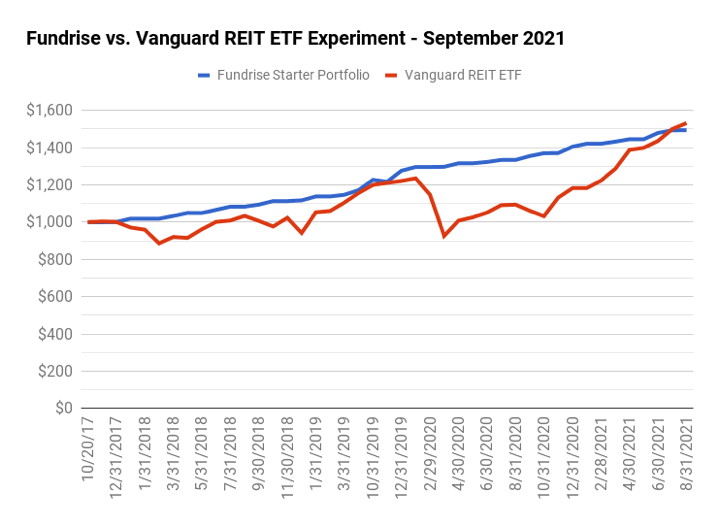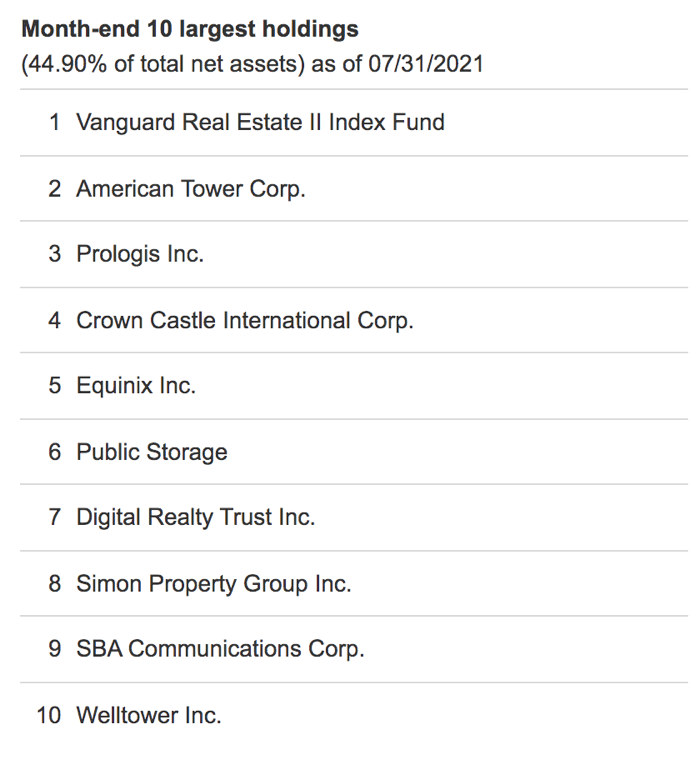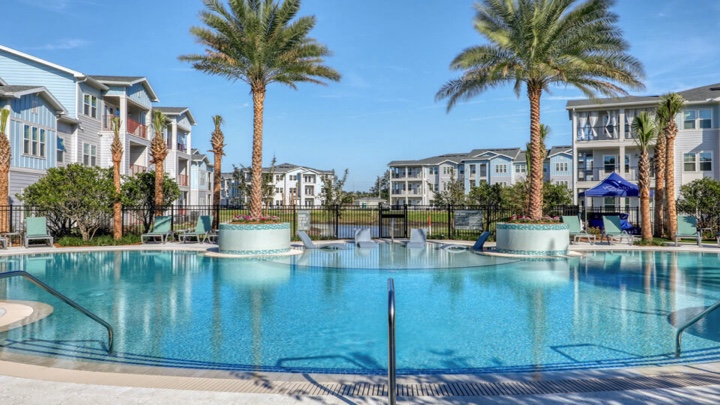
Updated September 2021. Here is my (nearly) 4-year update on my experiment comparing a and the from October 2017 to September 2021. In Fundrise, we have a start-up with “crowdfunding” beginnings that offers users a share of a concentrated basket of properties actively chosen from the private market. In Vanguard, we have a one of the largest real estate ETFs in the world – users own a tiny, tiny passive slice of 172 public-traded REITs. I invested $1,000 into both in October 2017 and the plan is to let them run for at least 5 years.

Fundrise Starter Portfolio background. When I bought in, the was a simple 50/50 mix of two eREITs: the Fundrise Income eREIT and the Fundrise Growth eREIT*. Since these are finite baskets of entire properties, over time they will close one fund and start another similar basket. What new investors are buying today will be different than what I bought in 2017. Each private eREIT works within recent crowdfunding legislation that allows all investors to own a basket of individual real estate properties (not just accredited investors with high net worth). The minimum deposit is now just $10. You must buy shares directly from Fundrise, and there are only limited quarterly liquidity windows as this is meant to be a long-term investment. There are also additional options available with higher investments:

Vanguard REIT ETF background. The (VNQ) is one of the largest index funds to invest in publicly-traded real estate investment trusts (REITs). You can purchase it via any brokerage account. You have the liquidity of being to sell on any day the stock market is open. A single share currently costs about $100, but many brokers offer fractional dollar-based trades if you want. All shareholders are holding the same ratio of (tens of?) thousands of office buildings, hotels, storage centers, nursing homes, shopping centers, apartment complexes, timber REITs, mortgage REITs, and so on. Here are the recent top 10 holdings:

Expenses. The Fundrise Starter Portfolio has an 0.85% annual asset management fee and a 0.15% annual investment advisory fee (1% “all-in” total). The Vanguard REIT ETF has an expense ratio of 0.12% on top, but each public REIT also has their own internal costs to manage their properties. In each case, investors are paying for real estate management, office space for those employees, etc. REITs may also use debt to increase their real estate exposure (leverage). Is the technology offered by Fundrise a more efficient way to invest in real estate?
Fundrise Portfolio updates.
- October 2017. $1,000 initial investment – 50 shares @ $10.00/share Income eREIT and 48.78 shares @ $10.25/share Growth eREIT.
- 2018. Total of $83.63 in dividend and capital gains distributions received in 2018. Based on balance of $1,117 on 12/31/18, this was a trailing 12-month yield of 7.48%.
- 2019. Total of $82.62 in dividend and capital gains distributions received in 2019. Based on balance of $1,276 on 12/31/19, this was a trailing 12-month yield of 6.47%.
- 2020. Total of $66.16 in dividend and capital gains distributions received in 2020. Based on closing price on 12/31/2020, this was a trailing 12-month yield of 5.59%.
- September 2021. Total of $40.82 in dividend and capital gains distributions received in 2021 YTD as of 7/31/2021.
- Final balance on 8/31/2021 was $1,494. (includes reinvested dividends).
Vanguard REIT ETF performance updates. I own VNQ and the mutual fund equivalent (same underlying holdings) in my retirement portfolio, but will be using Morningstar tools to track the performance of a $1,000 investment bought on the same date of 10/20/17.
- October 2017. $1,000 initial investment – 11.9545 shares at $83.65/share.
- 2018. Total of $3.53 in dividend and capital gains distributions per share received in 2018. Based on closing price of $74.57 on 12/31/18, this was a trailing 12-month yield of 4.73%.
- 2019. Total of $3.14 in dividend and capital gains distributions per share received in 2019. Based on closing price of $92.79 on 12/31/19, this was a trailing 12-month yield of 3.38%.
- 2020. Total of $3.33 in dividend and capital gains distributions per share received in 2020. Based on closing price of $84.94 on 12/31/20, this was a trailing 12-month yield of 3.92%.
- September 2021. Total of $1.26 in dividend and capital gains distributions received in 2021 YTD as of 7/31/2021.
- Final balance on 8/31/2021 was $1,532. (includes reinvested dividends).
Five-year time horizon. Both Fundrise and VNQ usually announce dividend distributions on a quarterly basis. Vanguard updates the NAV daily, but Fundrise only updates their NAV quarterly. Fundrise NAVs are only estimates as there is no daily market value available since they hold entire apartment complexes, office buildings, and so on (similar to your house, but with even fewer comps). Your liquidity from Fundrise is limited to quarterly windows that are not guaranteed. These are meant to be long-term investments so that they can sell at the desired time and avoid forced sales. Therefore, I plan on holding onto this investment for 5 years at the minimum. This will allow the investments to “play out” and also avoid any early redemption fees.

Commentary. After nearly 4 years, the final balances are basically tied at a 50% gain! Both turned $10,000 into $15,000 if you reinvested dividends and all other distributions. The Vanguard REIT has made a comeback after falling behind at the beginning of the pandemic. You could argue that really the Fundrise NAV simply didn’t account for what the actual pricing would be if they really had to liquidate in early or mid-2020. It could also be that VNQ will do better in good times, but worse in bad times.
This makes Fundrise similar to a rental property that looks more stable over time because you don’t get daily price quotes on your rental property. You’re really just guessing until something actually sells. Meanwhile, that physical piece of property is something you can visit and see people using (and paying rent). For example, I own part of the in Jacksonville, Florida (picture below). Here is a recent about a Fundrise property in Los Angeles. That feeling of stability and tangibility is a “pro” of private real estate. However, the “pro” of REITs is exposure to investment growth with zero ongoing management concerns. Fundrise tries to give you a bit of both – you get pictures and updates from the properties but zero management responsibility.

Bottom line. I’m nearly 4 years in my buy-and-hold-and-watch experiment where I compare investing in real estate via Fundrise direct investment and the largest REIT index ETF from Vanguard. At this point, both have created roughly a 50% gain, i.e. every $10,000 invested 4 years ago would be roughly $15,000 today. I will continue to make occasional updates, but won’t make any hard conclusions until after 5+ years.
You can learn more about . Anyone can invest with Fundrise; you don’t need to be an accredited investor. This is the second time I have invested with Fundrise. The first time ended when I decided to test out a withdrawal in my .
“The editorial content here is not provided by any of the companies mentioned, and has not been reviewed, approved or otherwise endorsed by any of these entities. Opinions expressed here are the author’s alone. This email may contain links through which we are compensated when you click on or are approved for offers.”
from .
Copyright © 2004-2021 MyMoneyBlog.com. All Rights Reserved. Do not re-syndicate without permission.